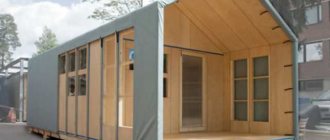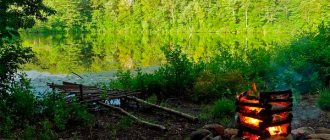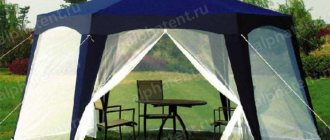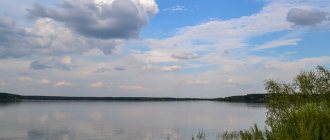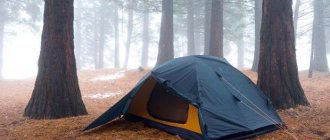Camp at a halt. How to organize a hiking camp?
When you're out in the wild, whether you're hiking, getting lost in the woods, or going on an overnight fishing trip, you should consider setting up a camp where you'll spend the night. An overnight stay in a well-organized camp will be more comfortable and safe, and a carefully thought-out infrastructure will solve many problems in advance.
As you may have guessed, today we will talk about how to properly set up camp in the wild and what you need to pay attention to first. Yes, many have not even thought that while spending the night in the wild, their life can be made a little better and more comfortable with the help of a properly organized resting place called a camp. But this is a whole art. Let's take a closer look at the problems that the right camp solves:
- Correct choice of parking place;
- Convenient location of tents and shelters;
- Allocation of working areas for collecting firewood and cooking;
- Proper location of the fire and eliminating the danger of fire of things and tents;
- Determining places for garbage and toilets;
- Eliminate chaos and disorder. Everything is in its place and everyone in the group knows these places;
- Availability of duty (sentinels) or alarm systems.
Of course, if there is not one or more problems that are solved in the above list, then the corresponding points are missed.
Selecting a location
It is necessary to pay maximum attention to the choice of a place for a camp, because a lot at a rest stop will depend on the choice of a place for a camp. There are several criteria according to which a camp site is chosen:
- Relief;
- Protection from wind;
- Protection from water;
- Protection from wild animals;
- Availability of resources;
- Free space.
The relief criterion refers to the shape and nature of the underlying surface where it is necessary to set up a camp. Choose a place with a flat underlying surface. There shouldn't be a lot of rocks or water there. Agree, it is equally uncomfortable to sleep on rocks, in a puddle or in a swamp.
Wind is a serious external irritant that will make your rest or survival process in the wild unbearable, especially when you want to take a break from a difficult and long journey and get some sleep. Therefore, you should choose a camp site in the most windless place, where the terrain and local landscape can protect your camp from air currents. It is imperative to camp on the leeward side of mountains or hills.
If you are camping near river banks, keep in mind that in some rivers, especially in mountainous areas, the water level can change quickly. Most often this happens during rains. To avoid getting into such trouble, you need to evaluate the surrounding space. If the water previously rose above its level, traces should remain.
In any case, you should not arrange an overnight stay in a low-lying place where there are no drainage systems. It is better to play it safe and choose a place in another area where the risk of flooding will be minimal.
Traveling through forests can sometimes involve the risk of encountering wild animals. These meetings will not always be friendly and welcoming. After all, you are in the territory of these animals and they have the right to protect their children, their home or food.
Therefore, never camp in areas where there are signs of wild animals. Such places may be the vicinity of watering holes, dens or food sites. If there is a risk of encountering large animals, you need to choose a place that can protect you from several sides. Be sure to identify escape routes.
Having resources close by is one of the main values for survival. Valuable resources include:
- Water;
- Food;
- Firewood.
In order to save energy and reduce effort, the camp must be located near bodies of water, where you will always have the opportunity to get water and catch fish for food. The presence of a nearby forest - a lot of firewood, building materials, mushrooms, berries and game. Try to find similar places and settle down there.
By free space we mean the concept of “plenty of space”, which will allow you to sit comfortably and not experience discomfort due to cramped spaces. After all, it’s not inconvenient to rest, cook or perform other tasks when everything is piled up and there is no passage.
Choosing a place to stay overnight
The first thing to think about is choosing the right place to sleep . The choice of location depends on the purpose. If parking is planned for a long time, then the choice of location should be approached carefully. It will take 2-3 hours to set up a good camp. If you need to take a short break, you don’t need to make efforts to create the greatest comfort. A short break will take half an hour.
Parking space
Basic rules for choosing a place to stay overnight.
- For a long overnight stay, a flat area without unnecessary thickets is suitable, so that you do not have to waste time cutting them down.
- It is advisable that there is a source of drinking water or a stream nearby.
- It is better not to choose a place in the lowlands and between the hills - it is dark and damp there, this attracts many insects and snakes.
- There are situations when people travel in extreme conditions without available means, or are forced to make an unexpected overnight stay in the forest. In this case, the place must be chosen among densely growing trees.
Once you have decided on your stopping place, you should make sure
We recommend reading:
How to choose equipment for a winter hike
Distribution of duties
Traveling in a group, when there is at least one other person besides you, you can significantly increase productivity by sharing responsibilities. By dividing labor, you can get more work done in less time.
After choosing a place to set up a camp, you need to decide on further tasks. These tasks are determined based on available resources and as needed.
Find the most necessary task. Next, determine the second most necessary, and so on, until you have no more needs that can be fulfilled at a given time and given the available resources.
When starting the most important task, you need to decide whether this task can be completed by one person. If so, then let the second one deal with a secondary task. Otherwise, all people in the group need to unite.
To effectively solve all the problems of arrangement, you need to distribute them as follows and organize the solution:
- Making a fire and arranging a place for it;
- Installation of shelters (tents);
- Supply of resources (water, food, firewood, etc.);
- Cooking food;
- Arrangement of specific places (place for waste, toilet);
- Arrangement of camp defense.
The above list is a superficial and inaccurate plan for separating responsibilities. After all, each of the list items can be divided into sub-items.
In the process of work, new and new tasks will constantly arise, for the solution of which it is necessary to allocate the necessary human resources.
In the case when you are alone in nature and survive, you need to perform the most important and necessary tasks that will have a beneficial effect on the survival process. For example, between the tasks of obtaining water or food, you must always choose water. After all, you can live without food for about three weeks, but without water you can hardly survive more than a few days.
Choosing a place for the fire
A common place for a fire is the center of the camp. Even in ancient times, at the very dawn of humanity, our ancestors gathered around the fire, which was located at the very central point of the settlement. There they prepared food, held rituals and meetings.
We will not break traditions and will follow the same layout. After all, it really is convenient and most suitable if your camp consists of two or more shelters (tents). When you are alone, the fire is located in a place where there are convenient approaches to it and it does not interfere with movement.
We’ve decided on the location, let’s start setting up the fire. To do this, we will need to dig a small depression and line it with stones. The recess is made so that the ashes are not scattered throughout the surrounding area, and stones placed around the fire will prevent its uncontrolled movement and improve fire safety.
Thanks to this simple technology, all the fire and, therefore, all the temperature will be concentrated at one point. Which, in turn, will increase its efficiency during cooking.
If there is a need, when you want to sit by the fire and think about the eternal or talk with your interlocutor, put benches. They can be made in a simple way, just place a log at a distance of 1-2 meters from the fire. The main thing is that the temperature from the flame should not be felt too much.
Setting up tents or shelters
In addition to choosing a campsite and location for the fire, you should carefully choose the layout of the tents. A good location of shelters will solve problems regarding safety and approach to them.
Let's take fire as a basis. It will be the defining point from which we will make all calculations and measure distances.
The best layout of tents is circular, when the shelters are located in a circle or semicircle. Naturally, as we said earlier, there is fire in the center.
All tents must have the entrance to the center. This will illuminate the entrance and not snag the guy wires.
Next, the tents need to be placed at a safe distance from the fire so that the sparks and heat from it do not cause problems for you. The optimal distance is 7–10 meters.
To protect against water flowing into shelters, they should be dug in with drainage outlets for water, in other words, with recesses. This way, when it rains, you won't wake up in a puddle of water. Yes, this won’t help during a rainstorm, but it will cope perfectly with moderate rains.
And one more thing, in places with the most intense traffic you should not install tent ropes; you will constantly catch them with your feet, especially in the dark.
Setting up a tent
- Don't pitch your tent in low areas. A flat or slightly elevated area is ideal. It would be good if there was wind protection on one side. Prepare the place: Remove branches, pine cones, stones. Anything that will interfere with a comfortable sleep.
- Make a backing. It will keep you warm and dry. Fern or spruce branches are suitable for it. To arrange a place for a tent, saw off the lowest branches. This will cause the least damage to the tree.
- Don't forget to dig around the perimeter of the tent area. A small gutter will prevent water from flowing under its bottom.
- Do not pitch your tent near trees with dry branches. This is a big threat to your safety in windy weather.
- Always securely secure tent pegs. If you find stones, press them against the edges of the awning along the perimeter. After additional “strengthening”, your overnight stay will not be afraid of the strongest winds.
- If you plan to put up several tents, place them at a distance of 5 meters from each other. This will ensure ease of installation and personal comfort.
- There should also be 5 meters from the fire to your place of overnight stay. Place it on the leeward side so that sparks and smoke do not interfere with your rest.
- Don't forget to put your gear and food in your tent at night. Thus protecting yourself from uninvited guests.
Read: Hitchhiking: getting ready to hit the road
Special places
We looked at places for fire and sleep in the previous subparagraphs of our article. Next, we should organize special places in our camp, which are necessary to complete certain tasks.
By special places in our context we mean the following:
- Place for eating;
- Place for collecting firewood;
- Place for garbage;
- Toilet.
Agree, it is much better to eat by the fire, so we will use the benches by the fire as a place to eat. To avoid the troubles that nature can provide us with in the form of precipitation, we need to make a canopy that will protect the fire from the rain, and cooking and eating food during this period will not be uncomfortable.
As a rule, this canopy over the fire is made of waterproof material: film, tarpaulin. But this is not always at hand. In the case when you need to set up a camp for a long period, you can build a serious roof or hut over the fire from branches and other roofing material that can be found in nature.
To prepare firewood, it is advisable to allocate a special place where you can store fuel for the fire and grind it. There is no need to do this in the center. Splinters and swinging movements while preparing firewood can injure someone or something. It is best to determine the place for collecting firewood on the outskirts of the camp, but also not far from the fire, because it is inconvenient to carry firewood over long distances.
In order not to scatter garbage throughout the camp, it needs to be put in one place. If possible, take it with you to civilization, where there are trash cans. There is no need to throw it away in the forest, think about the future of our children.
If it is not possible to take the waste with you, you need to bury it so that wild animals, having eaten the plastic cover of food or something else, do not harm themselves in any way.
The toilet is a place that absolutely needs to be taken care of. Not far from the camp, you need to dig two holes if there are both boys and girls in the group. These places will serve as toilets. Yes, it’s not aesthetically pleasing, but believe me, if you walk under the bushes, in a few days there won’t be a clean place in the area.
How to build a hut
If you have a tent and the necessary things, the rules are simple.
Hut
- Set up a tent. If there are several tents, then it is better to place them in the letter “g”, about 2-3 meters from each other. When traveling by car, the distance between cars parked in the forest should be small to block the wind. Your task is to position the tents or cars so as to form a semicircle, thereby preventing the entry of wind.
- In the center of the camp, place a fire for heating and cooking food, logs for sitting, and a drying rack for clothes.
- The toilet should be done at a distance from the camp. You can build it from available materials - leaves and branches, after digging a hole.
If you don’t have the necessary things, you will have to build a hut using available materials.
- Choose a place where the structure of the hut will rest on something. This could be a tree trunk, small thickets with branches.
- Create a canopy using branches and leaves. It’s good if you have a rope, an ax and a tarpaulin with you, but if you don’t have these things, then the structure will consist entirely of branches and leaves. The most important thing is to position it correctly and construct columns from logs as a support.
- Light a fire next to the hut and build a drying rack for clothes and a structure for cooking.
Alarm systems and night watch
In areas where there is a risk of encountering wild animals or other dangers, a camp protection system must be installed.
The solution is a passive proximity alarm system. To do this, the perimeter of the camp should be wrapped with rope. Place tin cans on the ropes, and throw stones or similar noisy objects inside them. When the animal touches the rope, you will hear a sound. The more ropes with signal objects you make, the higher the reliability.
An alarm system is good, but do not forget that it is not reliable. To avoid being caught off guard, post sentries. Divide the time you plan to sleep into equal parts. The number of these units should be a multiple of the number of people who will be on duty. Next, everyone, in turn, guards the camp and everyone at the rest stop.
